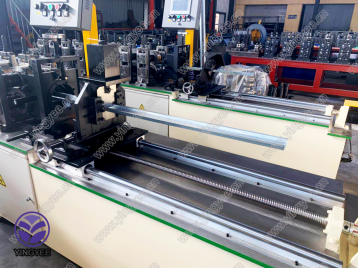
Understanding Channel Framing Roll Forming Machines
In the world of manufacturing, producing high-quality and precise components is essential for various industries, including construction, automotive, and furniture. One of the standout technologies that aid in this process is the channel framing roll forming machine. This specialized equipment plays a pivotal role in the production of channel frame components, which are widely utilized in structural applications due to their strength and versatility.
What is a Channel Framing Roll Forming Machine?
A channel framing roll forming machine is a type of machinery designed to convert flat metal sheets into channel-shaped profiles through a series of rolls. The process involves feeding a flat strip of metal, usually steel or aluminum, into the machine, where it is gradually shaped by passing through a sequence of rollers. Each set of rollers is specifically designed to bend and form the metal into a designated profile, resulting in a continuous length of channel that can be cut to desired sizes.
The Roll Forming Process
The roll forming process itself is a highly efficient method of producing long lengths of metal profiles with consistent dimensions. The raw material, often supplied in coil form, is unspooled and fed into the machine. As the metal strip moves through the various stages of the roll forming station, it undergoes gradual deformation until the final shape is achieved.
The roll forming machine typically consists of several critical components, including
1. Feeding Mechanism This system ensures a continuous and controlled feed of the metal strip into the rollers, maintaining uniformity in the production process.
2. Forming Rolls These are the heart of the machine, consisting of a series of shaped rollers that progressively form the strip into a channel profile. Each roller imparts a specific contour, allowing for intricate designs.
3. Cutting Mechanism After the channel frame has been formed, it is cut to the desired lengths. This section of the machine can utilize various cutting techniques, including shear cutting or flying shears, to ensure precision.

4. Control System Modern roll forming machines are equipped with advanced controls and automation features, allowing operators to program specifications and monitor processes efficiently.
Applications of Channel Frames
Channel frames produced by roll forming machines are widely used in numerous applications. They are an integral part of structural frameworks in buildings, acting as support beams or supports for other materials. Additionally, channel frames are expansive in the automotive industry, where they are used in vehicle chassis designs. Furniture manufacturers also utilize channel framing for producing durable and aesthetically pleasing products.
Advantages of Using Roll Forming
Choosing a channel framing roll forming machine offers several advantages over traditional manufacturing methods.
- Consistency The roll forming process provides a high level of consistency in product quality. Each channel frame is produced to exact specifications, minimizing the variance usually associated with other shaping methods.
- Efficiency Roll forming is a continuous process, enabling high production rates. This is particularly beneficial for manufacturers looking to produce large quantities of framing components in a limited timeframe.
- Material Utilization The process generates minimal waste, as excess material is often limited to shearing cuts. This not only reduces material costs but also supports sustainable manufacturing practices.
Conclusion
As industries continue to evolve and embrace advanced manufacturing technologies, channel framing roll forming machines stand out as vital tools that enhance productivity, efficiency, and quality in component production. By transforming flat metal into robust and reliable channel frames, these machines contribute significantly to the structural integrity of various applications. Embracing this technology can provide manufacturers with a competitive edge in an increasingly demanding marketplace. As businesses strive for innovation and sustainability, the role of roll forming machinery will undoubtedly become more pronounced, shaping the future of manufacturing.